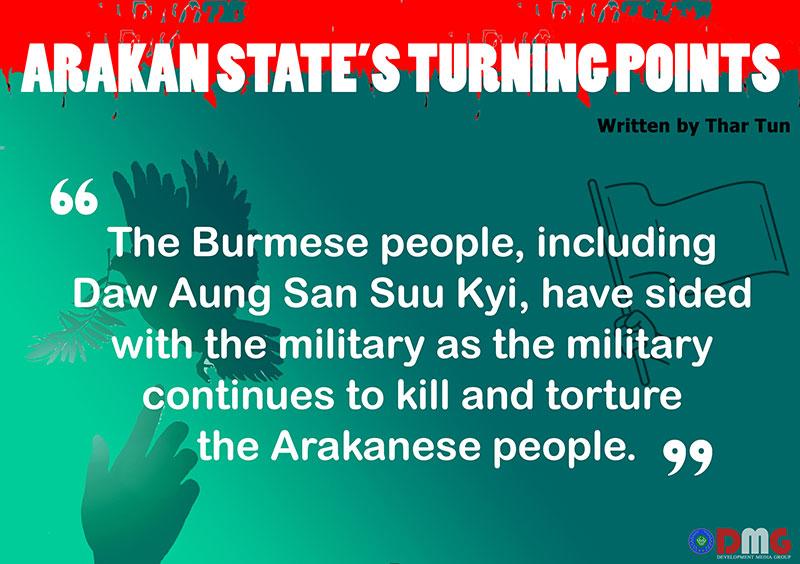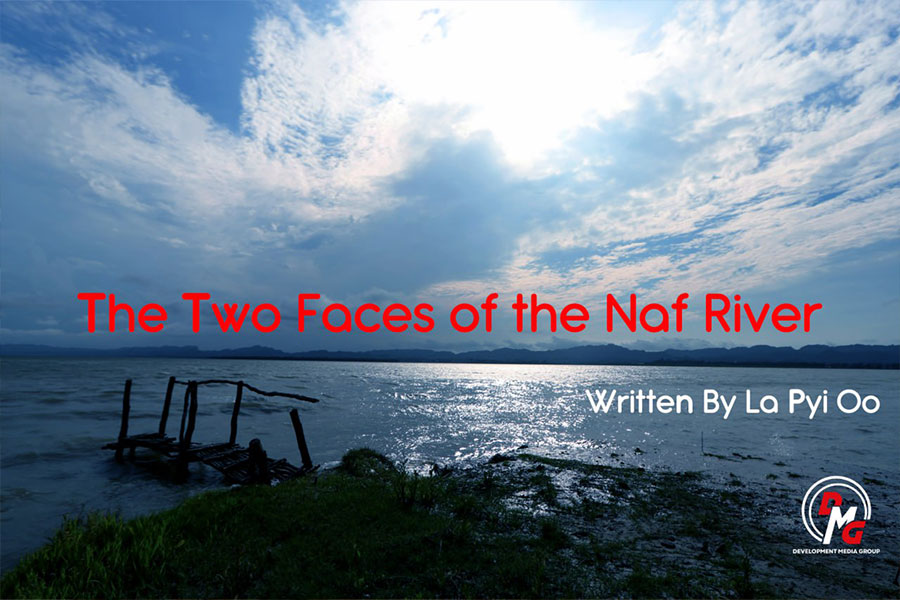- Junta unable to hold elections in dozens of wards and village-tracts in Sittwe, Kyaukphyu
- Fighting escalates between Myanmar military, Arakan Army in Ayeyarwady Region
- Regime steps up civilian arrests in Sittwe
- ULA safeguards Mrauk-U's ancient heritage
- Arakan on the Edge: What the DMG Landmine Impact Report Reveals About Myanmar's Deepening Humanitarian Crisis
Arakan State’s Turning Points
The Arakanese people had to fight the military and other opposing forces, including Daw Aung San Suu Kyi. Due to the internet shutdown, we even had to fight for access to information. The end result was that more and more Arakanese people joined or otherwise supported the armed uprising.
13 Sep 2021

Written by Thar Tun
The Burmese phrase “When the steel fist loosens” was in vogue in 2010, signalling the beginning of the country’s transition from military rule to democracy. In Myanmar’s politics, since independence in 1948, the bulk of the time has been spent under military rule.
The period under former dictator Senior General Than Shwe from 1990-2010 is widely considered to be the worst period of military rule. During that military regime, political parties were also outlawed. The formation of political parties and civil society was essentially nonexistent, and revolutionary groups were severely persecuted. The military drafted a constitution and began moving toward democracy in 2010, ostensibly to transition from military to civilian rule.
Between 1990 and 2010, Arakanese politicians focused on the overthrow of the military dictatorship; they mixed ethnic politics with Myanmar politics for political purposes, such as building a democratic federal system. There have been many Arakanese politicians who have been imprisoned for their lives in Myanmar politics. This period can be considered a period of mixed Arakanese politics. Revolutionary forces have been present from the beginning. Previously, there was only the Arakan Liberation Party (ALP) and the All Arakan Students’ & Youths Congress (AASYC), a group of educated young people, but their strength was small.
Turning Point No. 1
Elections were held in November 2010 after the 2008 Constitution was forcibly approved. It would be correct to say Myanmar’s politics was in turmoil at this time. The election was held with the majority of politicians, including Daw Aung San Suu Kyi, imprisoned; when politicians were heavily persecuted and people dared not even utter the word “politics”. It was a time of high anxiety and deep skepticism. Would the party that wins the election even be handed power, or would the winners be rearrested and imprisoned? In fact, the Tatmadaw (Myanmar military) had systematically drafted the constitution they wanted, and paved the way for them to go from outright dictators to party politicians in a quasi-democracy.
This was a difficult time for Arakanese and other ethnic politicians, who had to decide whether to run in (and by extension, legitimise) the election. The divide ultimately boiled down to those politicians who would run in the election and those who would not.
In Arakan State, the Arakan League for Democracy (ALD) — a powerful party in Myanmar’s 1990 election — decided not to run in the elections. Other Arakanese politicians saw a need to compete, and allow Arakanese people to elect a representative who shared their views and interests. This period marked a turning point for the Arakanese people, as a group of Arakanese politicians formed the Rakhine Nationalities Development Party (RNDP) and ran in the 2010 election, winning several seats in the state and national legislatures. The RNDP was among the most successful ethnic parties in all of Myanmar.
Not only did it benefit the Arakanese people when the iron fist was loosened; it was also a time when political speech was widely used. All the wounds that were previously closed are now open. In Shan, Mon and Karen, new political parties have emerged, not the existing NLD political partners.
In short, in Myanmar’s politics, the then-U Thein Sein administration became the government. The quasi-civilian government has faced many challenges, from military rule to civilian and decentralisation; from a closed market to a liberal economy to a market economy. At the national level, the Upper and Lower houses of the Pyidaungsu Hluttaw emerged, and an experiment in democracy began. Amid all of these happenings, the Arakanese people started to chart a political path for themselves, to some extent. I want to call this time the Arakanese political period.
Turning Point No. 2
In 2012, Arakan State was much-discussed and highlighted in the media. Communal violence between Muslims and Arakanese people began in June 2012, at a time when the main challenges in Myanmar politics were a complex peace process, constitutional reform and development. The problem has since spread from domestic to international in scope. U Thein Sein’s government was able to restore stability in Arakan State, but was not able to solve the problems at the heart of the 2012 conflict. To date, the problems in Arakan State have not been resolved.
The 2012 conflict marked a second turning point for the Arakanese people.
Turning Point No. 3
Let the Arakan National Conference, held in Kyaukphyu 2014, mark the third turning point. This conference was probably the most politically uniting and mobilising for the Arakanese people. The conference provided an opportunity for Arakanese revolutionary forces at home and abroad to meet and discuss in one place. This conference was a gathering for revolutionary forces, social forces and political forces. It was also a time of opportunity for armed forces.
The United League of Arakan and Arakan Army (ULA/AA), spurred by Kyaukphyu resident Dr. Nyo Twan Aung, became the most profitable and popular group at the conference. With the interests of the Arakanese people thereafter widely seen as intertwined with those of the ULA/AA, Arakanese youths began to take an interest in armed uprising.
Turning Point No. 4
Then there is the Thandwe conference, which in 2015 merged the RNDP and ALD under the name Arakan National Party (ANP). It was an internal party conference, but it was also a unification confab. The Arakanese people were watching and wanted the ANP to succeed.
However, the new ANP was plagued by old divisions in the years that followed. The 2015 Thandwe conference turned the tide of Arakanese politics and paved the way for political stagnation. The Thandwe conference was a sham, and did not achieve unification. During this period, Arakanese youths became disillusioned with politics and turned to armed resistance. The Arakan Army (AA) resorted to gunfire in Arakan State in 2015, and revolutionary sentiment began to rise.
Turning Point No. 5
The fifth turning point was the 2015 election. This election was an important period in Myanmar politics. The National League for Democracy (NLD), led by Daw Aung San Suu Kyi, won a landslide victory in the general election, but the ANP won a major victory in Arakan State. This was a time of separation of oil and water between Arakanese people and Daw Aung San Suu Kyi. After the ANP won in Arakan State, they wanted to form a state government. However, the Nobel laureate and the Arakanese people went their separate ways. With her party securing a sweeping electoral mandate nationally, Daw Aung San Suu Kyi did not allow the ANP, which won a majority of seats in Arakan State, to form a state government.
In the state parliament, all Arakanese MPs’ proposals were rejected and the Arakanese people’s voices were suppressed. Worst of all, the arrest and imprisonment of Dr. Aye Maung and writer Wai Hun Aung marked the narrowing of the Arakanese political framework. The use of firearms in the Mrauk-U protests subsequently pushed Arakanese youths to take up arms. At this point, a significant contingent of Arakanese youths finally chose armed uprising.
Turning Point No. 6
From 2019 to 2020, Arakan State was at the height of its conflict, and during this time, Daw Aung San Suu Kyi fanned the flames. She sided with the military, cut off internet access in much of Arakan State, and designated the Arakan Army (AA) as a terrorist group. She stood by the military even when Arakanese people were being killed and villages were being set on fire. Daw Aung San Suu Kyi’s position was the same as that of the Burmese people. None of the Burmese leaders urged the military to restore internet access in Arakan State amid the second wave of Covid-19.
At this point, Arakanese people young and old came to understand that this democracy was not for Arakanese people. The Arakanese people had to fight the military and other opposing forces, including Daw Aung San Suu Kyi. Due to the internet shutdown, we even had to fight for access to information. The end result was that more and more Arakanese people joined or otherwise supported the armed uprising.
Turning Point No. 7
The seventh turning point was the 2020 election period. The battlefields of Arakan and Chin states, which saw many casualties over the course of some two years of fighting, were still considered active in the lead-up to the election. While the Arakan Army (AA) was designated a terrorist group and clashed regularly with the Tatmadaw from late 2018 to late 2020, the ethnic armed group paved the way for dialogue and peace, even as the military launched an offensive using ground troops, navy and air forces. The Arakan Army (AA) has paved the way for further talks with the military through the Federal Political Negotiation and Consultative Committee (FPNCC), the political ally of the Northern Alliance, as an intermediary.
Later, a Japanese envoy arrived and a platform was opened for dialogue between the military and the Arakan Army (AA). I think by this time both the military and the AA had accepted that war was not the answer. Roundtable politics is the answer. Here, we are moving forward with understanding rather than a formal agreement between the military and the AA.
It was Daw Aung San Suu Kyi who had to create a formal platform for real peace talks. As a Nobel Peace laureate and democracy icon, Daw Aung San Suu Kyi should have systematically used her political skills. But instead of facilitating a peace dialogue, Daw Aung San Suu Kyi focussed on building an election in Arakan State to her liking. Elections were canceled in all or parts of nine Arakan State townships. The sense of disenfranchisement among Arakanese voters was significant.
Civilian-military relations are very important in Myanmar’s politics. The extent to which the military reduces its role in the country’s affairs will increase the scope of democracy. How much democracy should be demanded from the military? Whether to discuss or fight is very important for a new democracy. But a platform between the military and the NLD has long been missing.
In the end, Myanmar’s politics have returned to the starting point — back under the fist of a dictatorship. By the time Burmese youths were once again dying at the hands of the latest military regime, Arakan State had suffered two years of war and its aftermath, and many Arakanese people were already several steps into a systematic march behind the leadership of the Arakan Army.




















